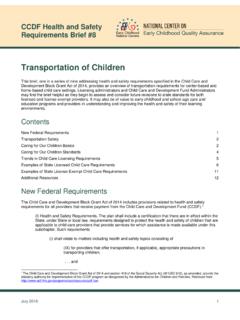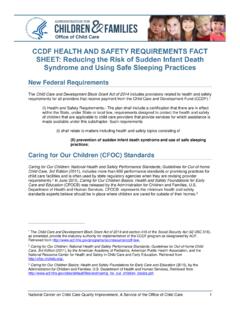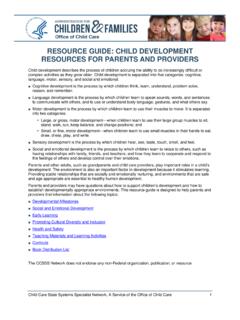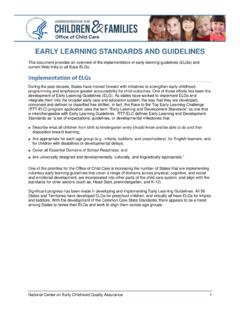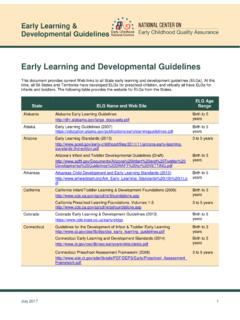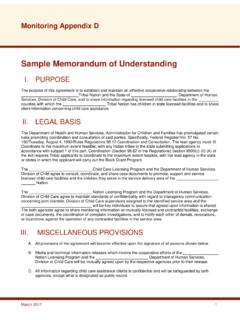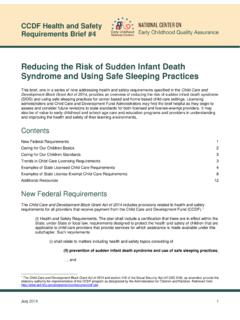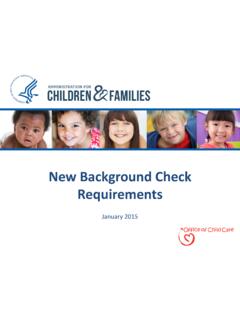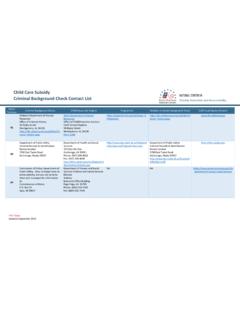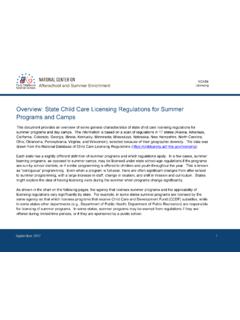Transcription of Caring for Our Children Basics Health and Safety Standards ...
1 CFOCB Standards Alignment Tool June 2016 1 Caring for Our Children Basics Health and Safety Standards Alignment Tool for Child Care Centers and Family Child Care Homes Contents Introduction ..4 Instructions ..4 CFOCB Health and Safety Standards Alignment Tool ..6 Staffing 6 Ratios for Centers and Family Child Care Homes 6 Background Screening 7 Pre-service Training/Orientation 7 First Aid and CPR Training for Staff 8 Continuing Education for Directors, Caregivers/Teachers in Centers, and Family Child Care Homes 8 Child Abuse and Neglect Education 9 Program Activities for Healthy Development 10 Monitoring Children s Development/Obtaining Consent for Screening 10 Personal Caregiver/Teacher Relationships for Birth to Five-Year-Olds 10 Methods of Supervision of Children 10 Supervision Near Water 11 Preventing Expulsions, Suspensions, and Other Limitations in Services 11 Prohibited Caregiver/Teacher Behaviors 12 Health Promotion and Protection 13 Active Opportunities for Physical Activity 13 Safe Sleep Practices and SIDS Risk Reduction 13 Routine Oral Hygiene Activities 14 Diaper Changing Procedure 14 Situations that Require Hand Hygiene 15 Routine Cleaning, Sanitizing, and Disinfecting 16 Prevention of Exposure to Blood and Body Fluids 16 Use of Tobacco, Alcohol, and Illegal Drugs 16 Emergency Procedures 17 CFOCB Standards Alignment Tool June 2016 2 Recognizing and Reporting Suspected Child Abuse, Neglect.
2 And Exploitation 17 Preventing and Identifying Shaken Baby Syndrome and Abusive Head Trauma 18 Sun Safety Including Sunscreen 18 Strangulation Hazards 18 Care Plan for Children with Special Health Care Needs 19 Inclusion/Exclusion/Dismissal of Children 19 Infectious Disease Outbreak Control 20 Medication Administration and Storage 20 Training of Caregivers/Teachers to Administer Medication 21 Nutrition and Food Service 22 Use of Department of Agriculture (USDA), Child and Adult Care Food Program (CACFP) Guidelines 22 Availability of Drinking Water 22 Care for Children with Food Allergies 23 Preparing, Feeding, and Storing Human Milk 23 Preparing, Feeding, and Storing Infant Formula 24 Warming Bottles and Infant Foods 24 Foods that Are Choking Hazards 25 Food Preparation Area Access 25 Compliance with Food and Drug Administration (FDA) Food Code and State and Local Rules 26 Facilities, Supplies, Equipment, and Environmental Health 27 Inspection of Buildings 27 Compliance with Fire Prevention Code 27 Environmental Audit of Site Location 27 Guardrails and Protective Barriers 28 Safety Covers and Shock Protection Devices for Electrical Outlets 28 Location of Electrical Devices near Water 29 Integrated Pest Management 29 Use and Storage of Toxic Substances 29 Carbon Monoxide Detectors 30 Safety of Equipment, Materials.
3 And Furnishings 30 Availability and Use of a Telephone or Wireless Communication Device 31 Cribs and Play Yards 31 Firearms 32 First Aid and Emergency Supplies 32 Play Areas/Playgrounds and Transportation 33 Location of Play Areas near Bodies of Water/Enclosures for Outdoor Play Areas/Enclosure of Bodies of Water 33 Prohibited Surfaces for Placing Climbing Equipment 33 Inspection of Indoor and Outdoor Play Areas and Equipment 34 CFOCB Standards Alignment Tool June 2016 3 Lifesaving Equipment 34 Water in Containers 35 Qualifications for Drivers 35 Child Passenger Safety 35 Interior Temperature of Vehicles 36 Passenger Vans 37 Infectious Disease 38 Immunization Documentation 38 Unimmunized Children 38 Immunization of Caregivers/Teachers 39 Policies 40 Written Plan and Training for Handling Urgent Medical Care or Threatening Incidents 40 Disaster Planning, Training and Communication/Emergency and Evacuation Drills 40 Sign-In/Sign-Out System 41 Authorized Persons to Pick Up Child 41 Record of Valid License, Certificate, or Registration of Facility or Family Child Care Home 42 Contents of Child Records 42 Frequency of Inspections for Child Care Centers and Family Child Care Homes 43 CFOCB Standards Alignment Tool June 2016 4 Introduction Caring for Our Children Basics (CFOCB)1 represents the minimum Health and Safety Standards experts believe should be in place where Children are cared for outside their own homes, whether in a home-based program or center-based facility.
4 It does not, however, represent all Standards that should be present to achieve the highest quality of care and early learning. For example, the caregiver training requirements outlined in these Standards are designed only to prevent harm to Children , not to ensure Children s optimal development and learning. Although use of Caring for Our Children Basics is voluntary, the Administration for Children and Families (ACF) hopes Caring for Our Children Basics will be a helpful resource for States and other entities as they work to improve Health and Safety Standards in both licensing and quality rating improvement systems (QRIS). This tool provides a simple format for States and Territories to compare their current early childhood program requirements and Standards against the recommended Health and Safety Standards in CFOCB. It may also be used as a reference by the following: Professional development program staff when reviewing training content Licensing staff and policy developers when drafting new Standards or best practice guidelines and training new staff Quality rating and improvement system staff when developing and evaluating quality Standards Training and technical assistance professionals in their work with child care providers Advocates and advisory councils as a blueprint for long-term planning Instructions 1.
5 Compare state licensing or QRIS Standards to Caring for Our Children Basics (CFOCB). State licensing or QRIS Standards can be copied into the standard section. The notes section can be used to document gaps in state Standards or ways state Standards exceed CFOCB Standards . 2. Indicate whether the state Standards reflect full, partial, or no alignment with each CFOCB standard. Full alignment means the two Standards align with one another on every element, but may not match word for word. For example, CFOCB , First Aid and CPR Training for Staff, reads as follows: All staff members involved in providing direct care to Children should have up-to-date documentation of satisfactory completion of training in pediatric first aid and current certification in pediatric CPR. Records of successful completion of training in pediatric first aid and CPR should be maintained in the personnel files of the facility.
6 1 Caring for Our Children Basics (CFOCB) is the result of work from both Federal and non-Federal experts. The Office of Child Care, Office of Head Start, Office of the Deputy Assistant Secretary for Early Childhood, and the Maternal and Child Health Bureau were instrumental in this effort. CFOCB is available at CFOCB is based on Caring for Our Children : National Health and Safety Performance Standards ; Guidelines for Early Care and Education Programs, Third Edition (CFOC3), developed by the American Academy of Pediatrics, the American Public Health Association, and the National Resource Center for Health and Safety in Child Care and Early Education, with funding from the Maternal and Child Health Bureau. CFOC3 is a collection of 686 national Standards that represent the best evidence, expertise, and experience in the country on quality Health and Safety practices and policies that should be followed in today s early care and education settings.
7 CFOC3 is often used by state regulatory agencies when they are revising and updating state child care regulations. CFOC3 is available at CFOCB Standards Alignment Tool June 2016 5 Check Alignment Level State Standard Notes Full Alignment Partial Alignment No Alignment The state standard reads, All caregivers with direct care responsibilities must have current certification in pediatric CPR and documentation of current training in pediatric first aid. Training records must be on file at the operation and available for review upon request. The following elements are found in both Standards : applies to all persons who provide direct care, requires pediatric first aid and pediatric CPR, training must be current, and documentation must be at the facility. Partial alignment means the state standard aligns with CFOCB on most but not all elements. The following example uses the same CFOCB standard, , First Aid and CPR Training for Staff.
8 All staff members involved in providing direct care to Children should have up-to-date documentation of satisfactory completion of training in pediatric first aid and current certification in pediatric CPR. Records of successful completion of training in pediatric first aid and CPR should be maintained in the personnel files of the facility. Check Alignment Level State Standard Notes Full Alignment Partial Alignment No Alignment The state standard reads, All direct caregivers must complete pediatric first aid training. At least one person per center, group or classroom must have training in pediatric CPR. Training records must be on file at the facility. The state standard does not require that all caregivers be certified in pediatric CPR. No alignment indicates that the state standard significantly varies from CFOCB; that is, fewer than half of the elements align with one another, no elements align with one another, or there is no state standard that aligns with CFOCB.
9 The following example uses the same CFOCB standard, , First Aid and CPR Training for Staff. All staff members involved in providing direct care to Children should have up-to-date documentation of satisfactory completion of training in pediatric first aid and current certification in pediatric CPR. Records of successful completion of training in pediatric first aid and CPR should be maintained in the personnel files of the facility. Check Alignment Level State Standard Notes Full Alignment Partial Alignment No Alignment The state standard reads, All staff members involved in providing direct care to Children should have up-to-date documentation of satisfactory completion of training in first aid. At least one person per center, group or classroom must have training in CPR. The state standard does not require pediatric first aid or pediatric CPR. Only one person per classroom is required to have CPR training, not all direct caregivers.
10 Training records are not addressed in the standard. 3. In addition to capturing alignment similarities and differences, the notes section can be used to capture information for implementation plans, stakeholder comments, ideas for future rule and standard development, or where the current state standard exceeds CFOCB recommendations. It can also be noted if the CFOCB standard is addressed in other ways such as policies or guidance. 4. Because this tool is lengthy, users can start by completing the sections of greatest interest by clicking on the topic title in the Table of Contents. Return to Table of Contents CFOCB Standards Alignment Tool June 2016 6 CFOCB Health and Safety Standards Alignment Tool Staffing Ratios for Centers and Family Child Care Homes Appropriate ratios should be kept during all hours of program operation. Children with special Health care needs or who require more attention due to certain disabilities may require additional staff on-site, depending on their needs and the extent of their disabilities.
